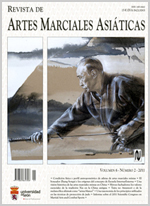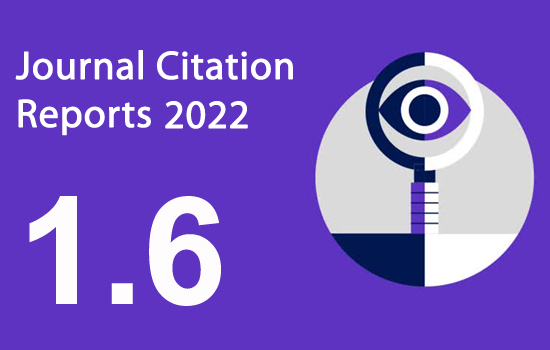Perfil antropométrico e motor de atletas de mixed martial arts
DOI:
https://doi.org/10.18002/rama.v6i2.4Palavras-chave:
artes marciais mistas, esportes de combate, avaliação físicaResumo
Objetivo: O objetivo desse estudo foi determinar o perfil antropométrico e motor de atletas de mixed martial arts (MMA) e a correlação entre essas variáveis.
Sujeitos e métodos: Treze atletas de MMA (30 ± 4 anos de idade) do sexo masculino participaram desse estudo, e foram submetidos a medidas antropométricas e aos testes: flexiteste adaptado, abdominais, flexões de braço, suspensão na barra, salto horizontal e 1RM no supino reto e agachamento.
Resultados: Os principais resultados foram: massa corporal (kg): 82.1 ± 10.9; %G: 11.87 ± 5.11; flexibilidade (pontos): 18.38 ± 4.07; abdominais (rep): 43 ± 11; flexões de braço (rep): 41 ± 9; suspensão na barra (s): 34 ± 11; salto horizontal (m): 2.19 ± 0.25; 1RM no supino reto (kg): 76 ± 23; 1RM no agachamento (kg): 73 ± 15. Além disso, os resultados apresentaram correlações significantes entre variáveis antropométricas e aptidão física: %G e salto horizontal (r= -0.75); %G e suspensão na barra (r= -0.67); estatura e 1RM no agachamento (r= 0.67); circunferência do braço e 1RM no supino (r= 0.77).
Conclusão: Os atletas de MMA envolvidos no presente estudo apresentaram baixo rendimento neuromuscular. A gordura corporal apresentou correlação negativa com o desempenho de potência e resistência muscular, enquanto a circunferência do braço esta relacionada positivamente com a força máxima de membros superiores.Downloads
Métricas alternativas
Referências
Amtmann, J. A. (2004). Self-reported training methods of mixed martial artists at a regional reality fighting event. The Journal of Strength and Conditioning Research, 18(1), 194-196.
Amtmann, J. A., Amtmann, K. A., & Spath, W. K. (2008). Lactate and rate of perceived exertion responses of athletes training for and competing in a mixed martial arts event. Journal of Strength and Conditioning Research, 22(2), 645-647.
Amtmann, J. (2010). High intensity training and the Mixed Martial Artist. New York: Nova Science.
Andreato, L. V., Moraes, S. M. F., Gomes, T. L. M., Esteves, J. V. C., Andreato, T. V., & Franchini, E. (2011). Estimated aerobic power, muscular strength and flexibility in elite Brazilian Jiu-Jitsu athletes. Science and Sports, (en prensa).
Araújo, C. G. S. (2004). Flexitest: an innovative flexibility assessment method. United States: Human Kinetics.
Artioli, G. G., Gualano, B., Franchini, E., Batista, R. N., Polacow, V. O., & Lancha, A. H., Jr. (2009). Physiological, performance, and nutritional profile of the Brazilian Olympic Wushu (kung-fu) team. The Journal of Strength and Conditioning Research, 23(1), 20-25.
Aruga, S., Onda, T., Aso, K., Yamashita, Y., Nakanishi, H., Shirase, H., et al. (2003). Measurement of barbell lifting capacity and making strength standards in judo players. Tokai Journal of Sports Medical Science, 15, 7-17.
Braith, R. W., Graves, J. E., Leggett, S. H., & Pollock, M. L. (1993). Effect of training on the relationship between maximal and submaximal strength. Medicine and Science in Sports and Exercise, 25(1), 132-138.
Braswell, M., Szymanski, D., Szymanski, J., Dixon, E., Gilliam, S., Wood, R., et al. (2010). Physiological Differences In Mixed Martial Artist And Traditional Martial Artists: A Pilot Study. The Journal of Strength and Conditioning Research, 24, 1.
Bratic, M., Radovanovic, D., & Nurkic, M. (2008). The effects of preparation period training program on muscular strenght of first-class judo athletes. Acta Medica Medianae, 46(4), 22-26.
Brown, L., & Weir, J. (2001). ASEP procedures recommendation I: accurate assessment of muscular strength and power. Journal of Exercise Physiology, 4(3), 1-21.
Clark, R. R., Oppliger, R. A., & Sullivan, J. C. (2002). Cross-validation of the NCAA method to predict body fat for minimum weight in collegiate wrestlers. Clinical Jounal of Sport Medicine, 12(5), 285-290.
Del Vecchio F. B., Hirata S, & Franchini E. (2011). A review of time-motion analysis and combat development in mixed martial arts matches at regional level tournaments. Perceptual and Motor Skills, 112(2), 639-648.
Doria, C., Veicsteinas, A., Limonta, E., Maggioni, M. A., Aschieri, P., Eusebi, F., et al. (2009). Energetics of karate (kata and kumite techniques) in top-level athletes. European Journal of Applied Physiology, 107(5), 603-610.
Fagerlund, R., & Hakkinen, H. (1991). Strength profile of finnish judoists-measurement and evaluation. Biology of Sport, 8(03), 143-149.
Franchini, E., Del Vecchio, F. B., Matsushigue, K. A., & Artioli, G. G. (2011). Physiological profiles of elite judo athletes. Sports Medicine, 41(2), 147-166.
Franchini, E., Nunes, A. V., Moraes, J. M., & Del Vecchio, F. B. (2007). Physical fitness and anthropometrical profile of the Brazilian male judo team. Journal of Physiological Anthropology, 26(2), 59-67.
Franchini, E., Takito, M. Y., & Bertuzzi, R. (2005). Morphological, physiological and technical variables in high-level college judoists. Archives of Budo, 1, 1-7.
Giampietro, M., Pujia, A., & Bertini, I. (2003). Anthropometric features and body composition of young athletes practicing karate at a high and médium competitive level. Acta Diabetologica, 40(1), 145-148.
Heller, J., Peric, T., Dlouha, R., Kohlikova, E., Melichna, J., & Novakova, H. (1998). Physiological profiles of male and female taekwon-do (ITF) black belts. Jounal of Sports Sciences, 16(3), 243-249.
Horswill, C. A., Miller, J. E., Scott, J. R., Smith, C. M., Welk, G., & Van Handel, P. (1992). Anaerobic and aerobic power in arms and legs of elite senior wrestlers. International Journal of Sports Medicine, 13(8), 558-561.
Imamura, H., Yoshimura, Y., Uchida, K., Nishimura, S., & Nakazawa, A. (1998). Maximal oxygen uptake, body composition and strength of highly competitive and novice karate practitioners. Applied Human Science, 17(5), 215-218.
Johnson, B. L., & Nelson, J. K. (1979). Practical Measurements for Evaluation in Physical Education. Minnesota: Burgess.
Kraemer, W. J., Fry, A. C., Rubin, M. R., Triplett-McBride, T., Gordon, S. E., Koziris, L. P., Lynch, J. M., Volek, J. S., Meuffels, D. E., Newton, R. U., & Fleck, S. J. (2001). Physiological and performance responses to tournament wrestling. Medicine and Science in Sports and Exercise, 33(8), 1367-1378.
Kraemer, W. J., Vescovi, J. D., & Dixon, P. (2004). The physiological basis of wrestling: Implications for conditioning programs. Strength and Conditioning Journal, 26(2), 10-15.
Krstulovic, S., Zuvela, F., & Katic, R. (2006). Biomotor systems in elite junior judoists. Collegium Antropologicum, 30(4), 845-851.
Little, N. G. (1991). Physical performance attributes of junior and senior women, juvenile, junior, and senior men judokas. Journal of Sports Medicine and Physical Fitness, 31(4), 510-520.
Lohman, T. G. (1992). Advances in body composition assessment. Canada: Human Kinetics
Milanez, V., Lima, M.S, Gobatto, C., Perandini, L., Nakamura, F., & Ribeiro, L. (2010). Correlates of session-rate of perceived exertion (RPE) in a karate training session. Science and Sports, 26(1), 38-43.
Mirzaei, B., Curby, D. G., Rahmani-Nia, F., & Moghadasi, M. (2009). Physiological profile of elite Iranian junior freestyle wrestlers. Journal of Strength and Conditioning Research, 23(8), 2339-2344.
Pollock, M. L., Wilmore, J. H., & Fox, S. M. (1990). Exercise in health and disease: evaluation and prescription for prevention and rehabilitation (2ª ed.). Philadelphia: Saunders
Probst, M. M., Fletcher, R., & Seelig, D. S. (2007). A comparison of lower-body flexibility, strength, and knee stability between karate athletes and active controls. Journal of Strength and Conditioning Research, 21(2), 451-455.
Roschel, H., Batista, M., Monteiro, R., Bertuzzi, R., Barroso, R., Loturco, I., Ugrinowitsch, C., Tricoli, V., & Franchini, E. (2009). Association between neuromuscular tests and kumite performance on the Brazilian Karate National Team. Journal of Sports Science Medicine, 8(3), 20-24.
Rouveix, M., Bouget, M., Pannafieux, C., Champely, S., & Filaire, E. (2007). Eating attitudes, body esteem, perfectionism and anxiety of judo athletes and nonathletes. International Journal of Sports Medicine, 28(4), 340-345.
Sbriccoli, P., Camomilla, V., Di Mario, A., Quinzi, F., Figura, F., & Felici, F. (2010). Neuromuscular control adaptations in elite athletes: the case of top level karateka. European Journal Applied Physiology, 108(6), 1269-1280.
Schick, M. G., Brown, L. E., Coburn, J. W., Beam, W. C., Schick, E. E., & Dabbs, N. C. (2010). Physiological Profile of Mixed Martial Artists. Medicina Sportiva, 14(4), 182-187.
Schmidt, W. D., Piencikowski, C. L., & Vandervest, R. E. (2005). Effects of a competitive wrestling season on body composition, strength, and power in National Collegiate Athletic Association Division III college wrestlers. Journal of Strength and Conditioning Research, 19(3), 505-508.
Sertic , H., Segedi, I., & Milanovic , D. (2006). Anthropological and fitness status of Croatian judoists. Archives of Budo, 2, 24-27.
Shephard, R. J. (1988). PAR-Q, Canadian Home Fitness Test and exercise screening alternatives. Sports Medicine, 5(3), 185-195.
Silva, J. J. R., Vecchio, F. B. D., Picanço, L. M., Takito, M. Y., & Franchini, E. (2011). Time-Motion analysis in Muay-Thai and Kick-Boxing amateur matches. Journal of Human Sport and Exercise, 6(3), 1-7.
Sterkowicz-Przybycie, K. (2010). Technical diversification, body composition and somatotype of both heavy and light Polish jujitsukas of high level. Science and Sports, 25(4), 194-200.
Taylor, A. W., & Brassard, L. (1981). A physiological profile of the Canadian judo team. Journal of Sports Medicine and Physical Fitness, 21(2), 160-164.
Thomas, S. G., Cox, M. H., LeGal, Y. M., Verde, T. J., & Smith, H. K. (1989). Physiological profiles of the Canadian National Judo Team. Canadian Journal of Sport Sciences, 14(3), 142-147.
Toskovic, N. N., Blessing, D., & Williford, H. N. (2002). The effect of experience and gender on cardiovascular and metabolic responses with dynamic Tae Kwon Do exercise. Journal of Strength and Conditioning Research, 16(2), 278-285.
Toskovic, N. N., Blessing, D., & Williford, H. N. (2004). Physiologic profile of recreational male and female novice and experienced Tae Kwon Do practitioners. Journal of Sports Medicine and Physical Fitness, 44(2), 164-172.
World Health Organization (2010). BMI classification. Disponible en http://apps. who.int/bmi/index.jsp?introPage=intro_3.html. [Consulta 11/29/ 2010].
Yoon, J. (2002). Physiological profiles of elite senior wrestlers. Sports Medicine, 32(4), 225-233.
Downloads
Publicado
Como Citar
Edição
Secção
Licença
Direitos de Autor (c) 2012 Bruno Ferreira Marinho, Fabrício Boscolo Del Vecchio, Emerson Franchini

Este trabalho encontra-se publicado com a Licença Internacional Creative Commons Atribuição-NãoComercial-CompartilhaIgual 4.0.
Os autores que publicam nesta Revista estão de acordo com os seguintes termos:
- Os autores cedem, de forma exclusiva, os direitos de exploração (reprodução, distribuição, comunicação pública, transformação) à Universidade de Léon, podendo estabelecer, em separado, acordos adicionais para a distribuição não exclusiva da versão do artigo publicado na Revista (por exemplo: alojar no repertório institucional ou publicá-lo num livro), com o reconhecimento da publicação inicial nesta Revista.
- O trabalho encontra-se na Creative Commons Attribution-Non Commercial-Share Alike 4.0 International License. Pode-se consultar aqui o resumo e o texto legal da licença.
- Permite-se, e sugere-se, que os autores difundam electronicamente as versões pré-impressão (versão antes de ser avaliada) e pós-impressão (versão avaliada e aceite para publicação das suas obras antes da sua publicação), favorecendo a sua circulação e difusão, e com ela o possível aumento da sua citação e alcance pela comunidade académica.











